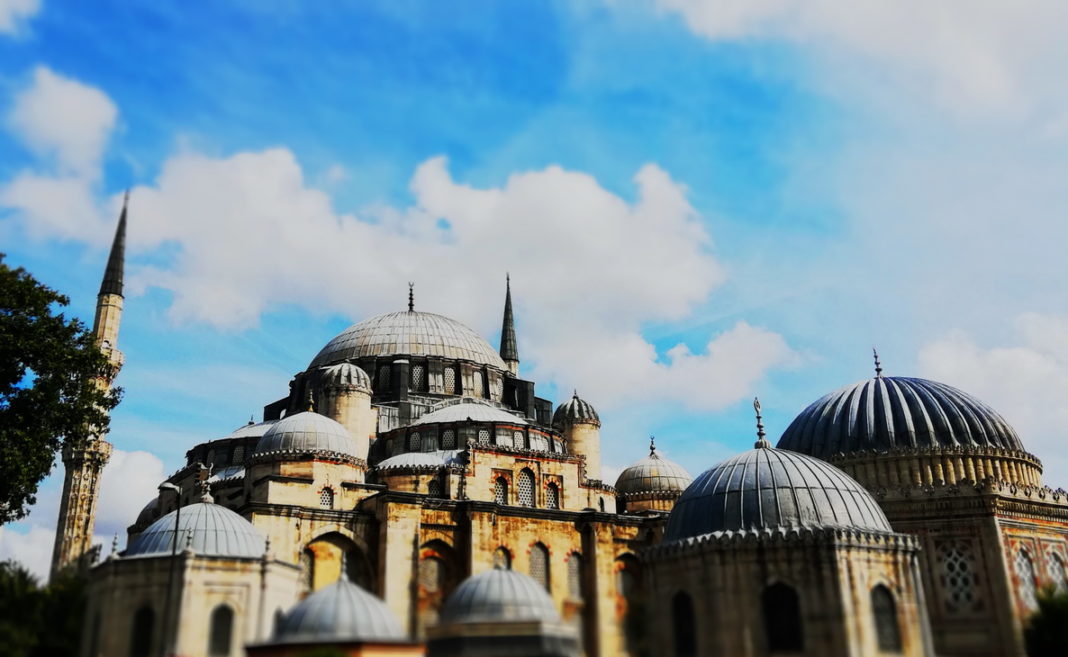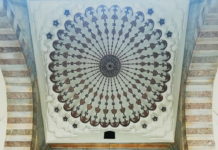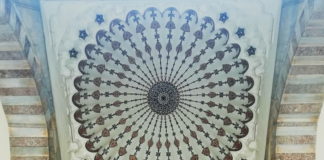Table of Contents
The Magnificent Mosques of Istanbul
The great Mosques that define Istanbul’s skyline and express the aesthetics of the Ottoman Empire at its apex are all the work of one extraordinary man: Mimar Sinan (The Architect Sinan). He’s also known as the Great Sinan, Mimar Koca Sinan (The Great Architect Sinan) and – Eurocentrically – as the Michelangelo of the Ottoman Empire.
On a recent trip to Istanbul, my chief wish was to experience the works of Sinan and learn more about this definitive architect. Our private tour “Ottoman Architecture: Istanbul’s Magnificent Mosques” gave us a depth of understanding and an experience of great beauty.
Visiting the great mosques of Istanbul is a defining experience of the city, along with seeing Agia Sophia, the colorful houses of Balat, and the swirl of activity in the spice market.
Understanding History and Architecture in Context
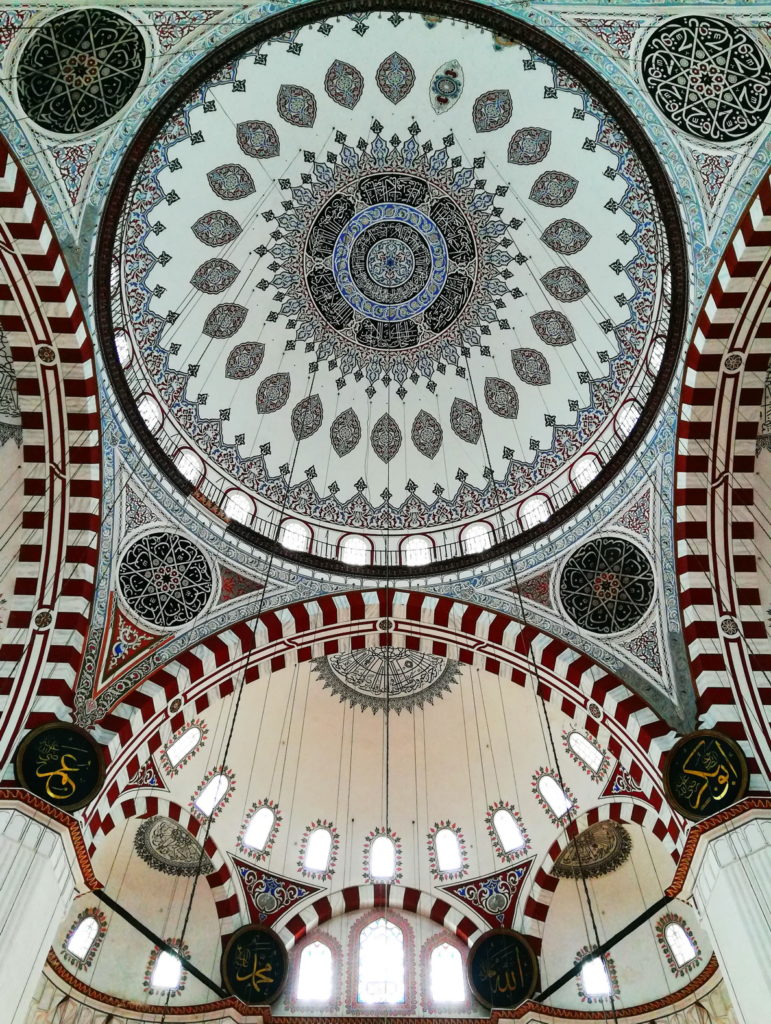
Our visit to two splendid mosques by Mirmar Sinan truly did provide context. Our tour with our guide Ebru began with an introduction to the history of the Ottoman Empire at its height. In addition to the story of Mimar Sinan, we also learned the tales of the people behind the mosques- the Sultan Suleiman the Magnificent, the powerful favorite Roxelana – the legendary Hürrem Sultan – and the sons they lost.
We were glad that our tour was at the beginning of our stay in Istanbul. For it was not only history that our excellent guide Ebru illuminated for us, but the architecture itself. Because of our tour, we had an introduction to the principals and elements of Islamic architecture and design. This opened up a world of appreciation and meaning on our other mosque visits throughout our stay.
For a glossary of terms for understanding the basics of Islamic worship, Mosque architecture and decorative motifs, please read here.
Mimar Sinan
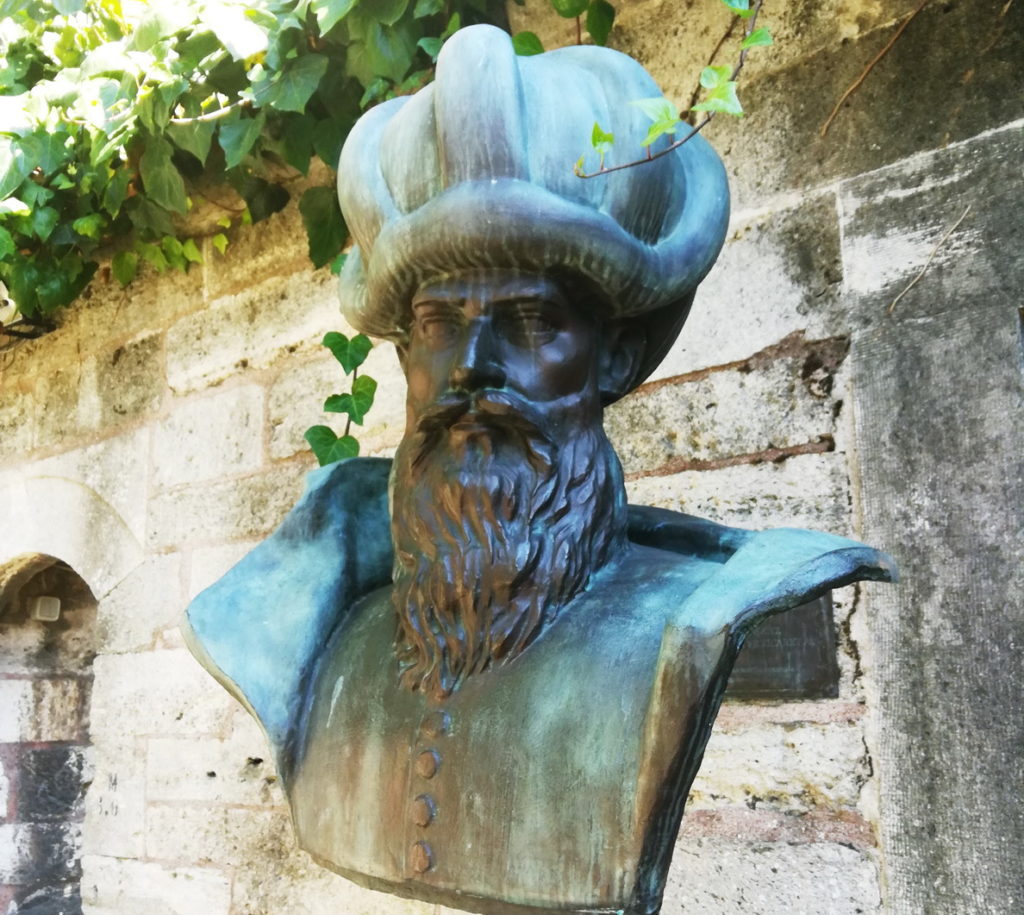
Mimar Sinan was chief architect of the Ottoman Empire when the empire was at its most powerful. At one time, the Ottoman Empire covered 12 million square kilometers, including much of the Arabian peninsula, North Africa, the Balkans, and Southeastern Europe up to Vienna.
The reign of Suilleiman the Magnificent was the golden age of the Ottoman Empire. Mimar Sinan gave the empire’s grandeur its monumental expression.
Sinan had a long life (1490 – 1588), and an enormously productive career. He entered the service of the sultan though the Devshirme. This was the act of conscription the strongest and ablest boys of Christian families into the service of the empire. They converted to Islam and many became Janissaries, the elite of Ottoman military corps. They could even rise to the rank of Grand Vizier – the head of government.
Sinan already had a foundation in architecture. His father had been a stone mason and Sinan assisted him. After his conscription, Sinan trained as an architect while also training as an officer. On military campaigns, he was able to study architectural masterpieces. Sinan initially constructed buildings, fortresses, and bridges. His works are in cities throughout the former Ottoman empire.
Mimar Sinan and the White Tower of Thessaloniki
Among the military fortifications built by Sinan is – possibly – the symbol of Thessaloniki, the White Tower – or Lefkos Pirgos. Sinan built architecturally similar fortresses, on in particular is in Albania. Sinan also built mosques that are still standing in Greece. Among these are the Osman Shah Mosque in Trikala, the Zincirli Mosque of Serres, and the Kurşunlu Mosque of Kastoria.
The Many Works of Mimar Sinan
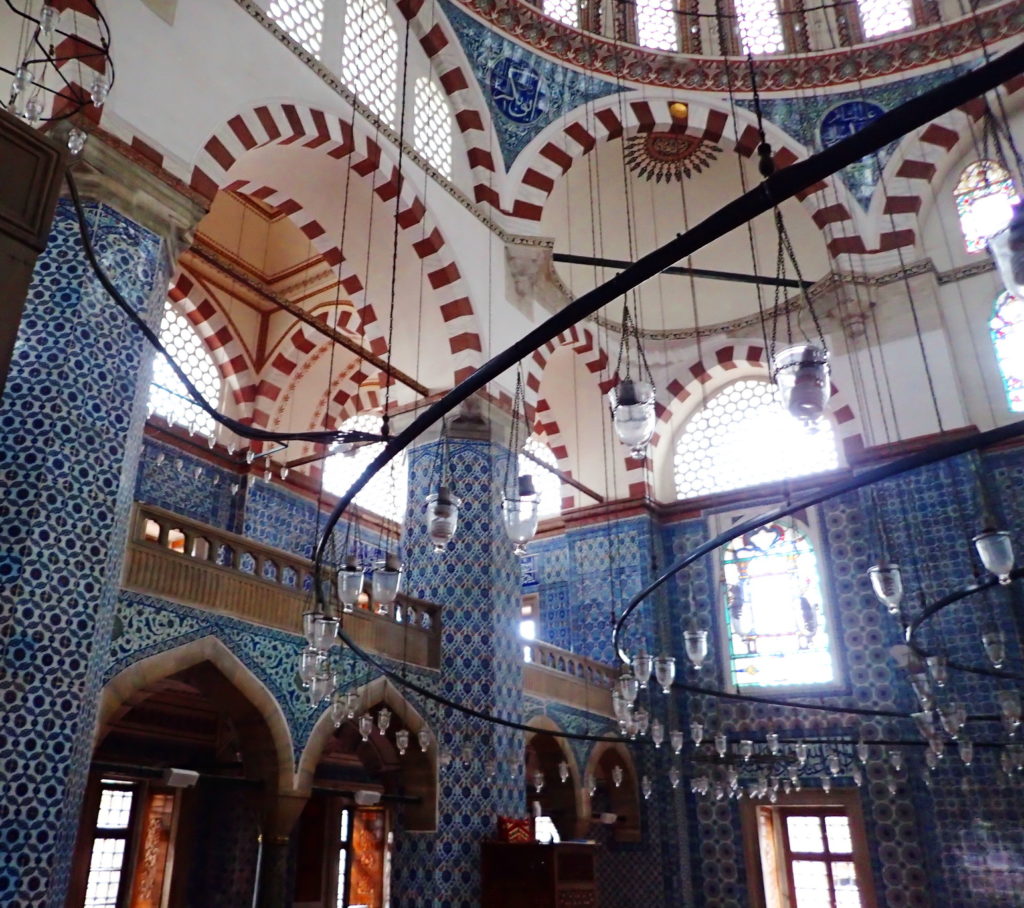
Even though by most accounts he was nearly 50 years old at the time of his appointed to the Imperial court, Sinan enjoyed an enormously productive career. Sinan built over 80 – by some accounts over 90 – mosques. He also built many mescid (smaller mosques), baths, caravanserais, medreses (schools of theology), hospitals, imarets (charity kitchens), turbes (masoleums), and public works such as bridges and aqueducts. In addition, he also built mansions and palaces.
The excellence of even his early works display his maturity.
The Mosques of Mimar Sinan in Istanbul
The skyline of Istanbul is an architectural poem. Understanding this glorious city and its architecture is central to an itinerary of Turkey. And to do that, one must become acquainted with magnificent works of Sinan, architect of a defining feature of that skyline. Sinan designed the magnificent and iconic Süleymaniye Mosque, high on one of Istanbul’s seven hills. It’s a glory to see from the opposite side of the Golden Horn.
This is one of Istanbul’s most famous mosques, and one of several Istanbul Mosques that Sinan designed. Some are nearly equal in grandeur; others are more modest, and one is even hidden in a maze of fragrant shops. The Sulleimaniye is traced against the evening sky, and the Cihangir shimmers on the surface of the Bosporous. Some have a sad tale – like the Cihangir Mosque and the splendid Şehzade Mosque. One – the Mihrimah Sultan Mosque – even has a love story (maybe …). This is the tale of three of them.
The Şehzade Mosque
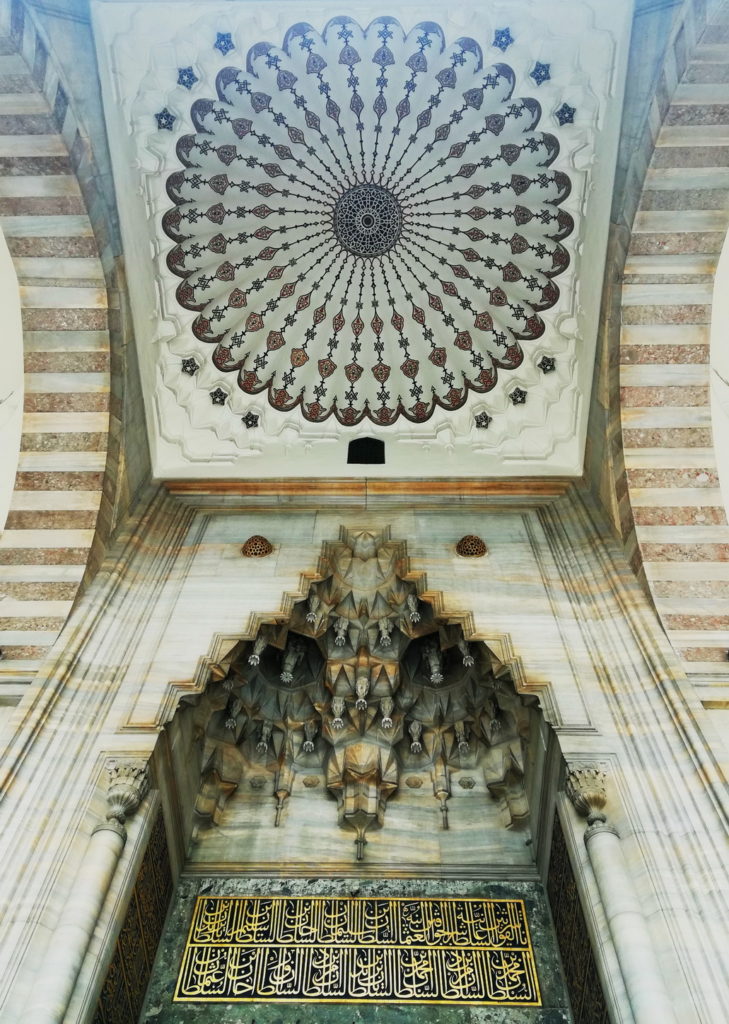
Our tour began not in a tourist area but in a neighborhood near the University, with broad boulevards, tidy shops, and street vendors making elaborate sandwiches in charming red and white carts.
We met our guide Ebru across from a large walled garden. We could glimpse minarets over the tops of the walls.
The Şehzade Mosque complex of 1543 – 1548, stunning as it is, was a work of Mimar Sinan’s apprenticeship. Sinan took care to make the Mosque a place of reflection. As soon as you pass through the arch in the stone wall and enter the mosque’s complex, the scent of sweet pines greets you. There is a large and lush garden to make your way through as you approach the Mosques’s entrance. The fragrant garden isolates the mosque from the sounds and scents of the street. The tranquility prepares you for prayer and contemplation.
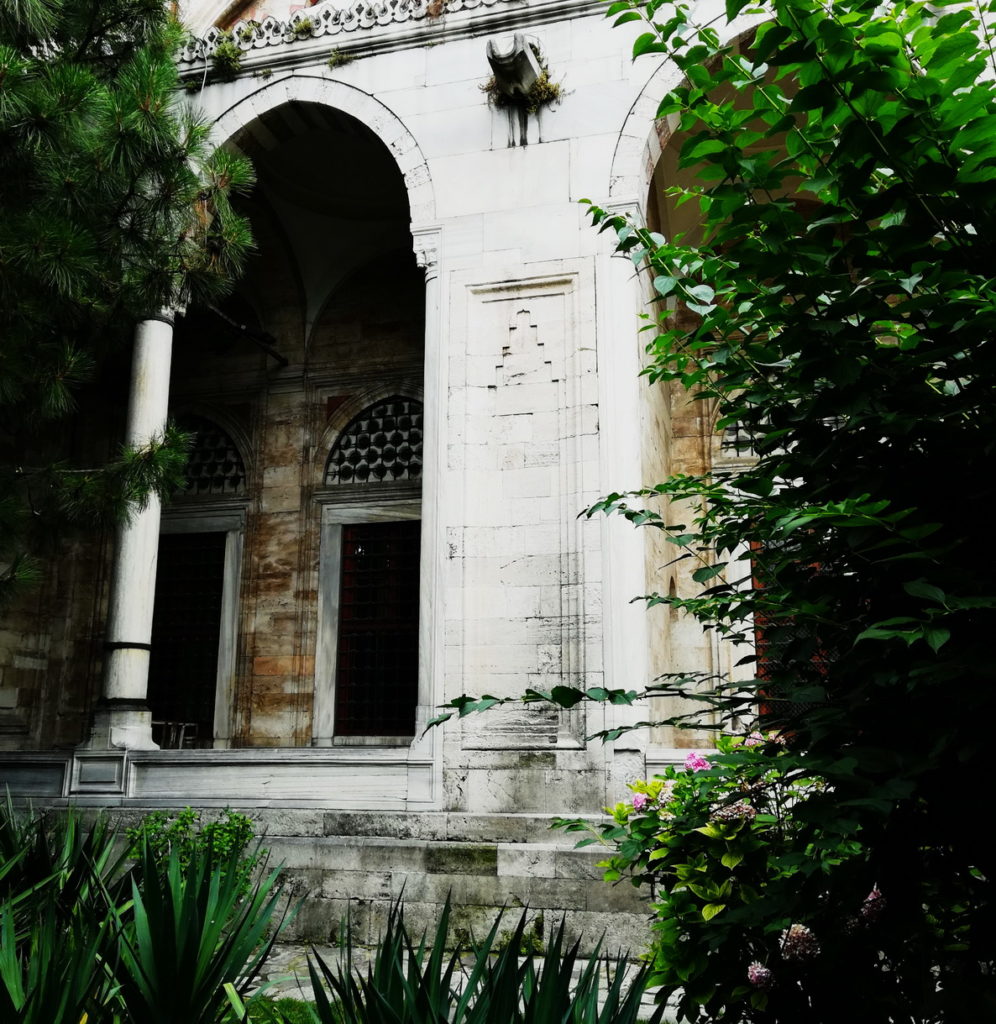
The enclosed courtyard is large and elaborate. Ebru tells us this is perhaps to balance the relatively spare interior. The Şehzade Mosque is a memorial Mosque – it means “The Mosque of the Crown Prince.” Sulleiman the Magnificent had it built in memory of the son he had hoped would succeed him. Şehzade Mehmed died at age 22 under mysterious circumstances, after returning from a successful military campaign in present-day Hungary. He was the son of Sulleiman with his beloved Hürrem Sultan – the legendary Roxelana (and her story is a fascinating one).
A Mosque of Reflection and Benevolence

Although built in sadness, the Şehzade Mosque has a strong positive energy. Peace and tranquility fill you on entering. In the vast space, large widows at ground level look out into the garden, and illuminate the pages of the Koran at individual stations for private study. Cats wander freely through the Mosque. One joined us, reclining on Ebru’s map. The Şehzade Mosque is filled with a profoundly benevolent mood that transcends both faiths and species alike.
The Süleymaniye Mosque
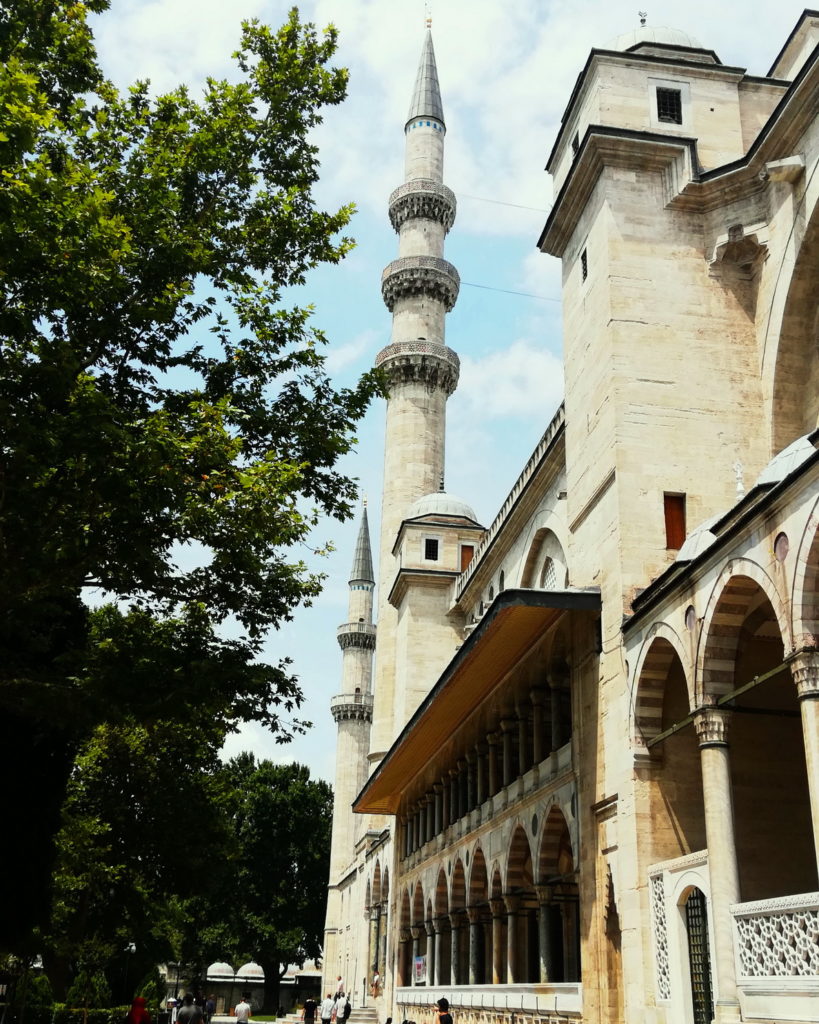
This is the best known Mosque of Istanbul. Although the Blue Mosque – built by an apprentice of Mimar Sinan – may be more common in name, the grandeur of the Süleymaniye Mosque, 1550 -1557, crowns the city from the third of Istanbul’s seven hills. The mosque and the silhouette of its minarets against the golden sky of evening is the definitive Istanbul view.
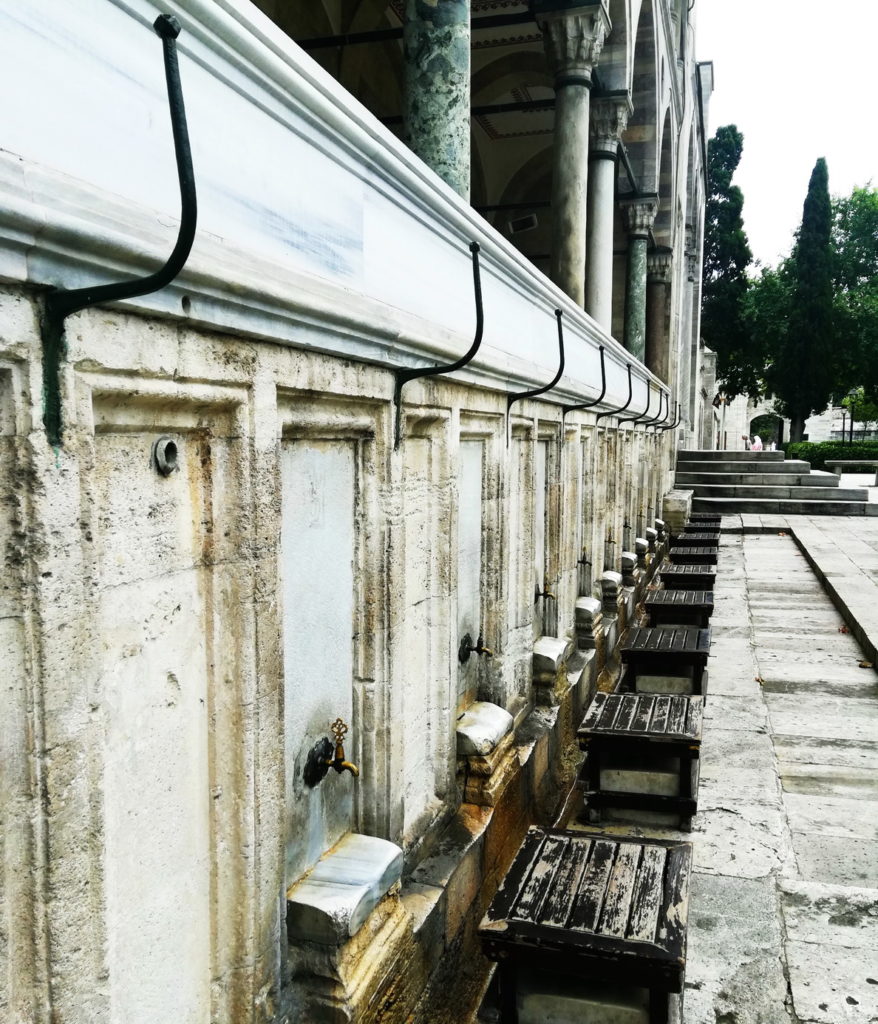
The Mosque belongs to an entire complex. At one time, it included a hospitals, baths, a caravanserai, an imaret (charity kitchen), and medrese (schools for studying the Koran). It also has the glorious turbes (masoleum) of Suleiman the Magnificent and Hürrem Sultan.
There were rules for building an Imperial Mosque. The Sultan needed to build it on land he owned or purchased at a fair price. The cost of the construction had to come from new conquests, of which 1/5 was his “righteous share.” From this, a Sultan could build an Imperial Mosque.
This prime Istanbul location had once been the Imperial Palace. But it had fallen into disrepair. In the meantime, Suleiman the Magnificent and the Imperial household and court had been using the glorious Topkapi Palace. After a fire, he dismantled the old palace. It was the ideal site for his Imperial Mosque, the grand Süleymaniye.
A Work of Mimar Sinan in his Prime
The 17th century traveler and chronicler Evliya Çelebi considered the Süleymaniye mosque to be a work of Mimar Sinan’s peak. He called the Şehzade Mosque (1543 -1548) a work of Sinan’s apprenticeship, and Edirne’s Selimye Mosque (1568 – 1575) the culmination of his maturity. The Selimye Mosque is widely regarded a masterpiece of Islamic architecture.
The Süleymaniye Mosque and Agia Sophia
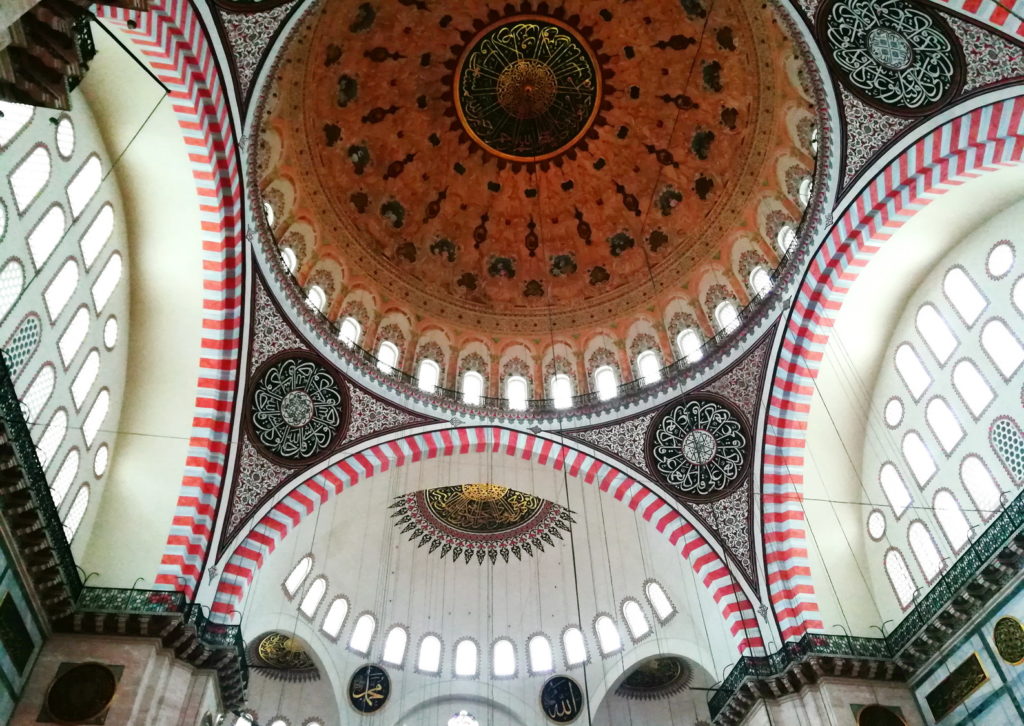
The glorious 6th century Agia Sophia was Mimar Sinan’s model in designing the Süleymaniye. He emulated the structure of a central dome, two semi-domes, and then exedra- semi-circular recesses. With its straight sides, this design unites the oblong basilica shape with a central dome, as in Agia Sophia. The dome is 53 meters high, and, like Agia Sophia’s appears to hover weightlessly in the heavens thanks to a ring of windows at the dome’s base. He did not match the 55 m height of Agia Sophia’s dome. (But he eventually would, surpassing it in his magnificent design for the Selimye Mosque).
The Ingenuity of Design of the Süleymaniye Mosque
Mimar Sinan employed ingenious devices in his design of the Süleymaniye Mosque. For acoustics, he took inspiration from the Greek technique. He used clay pots to reflect and amplify the sound. 256 such pots, undetectable with mouths of just 1.5 centimeters wide, are embedded in the dome.
Candles lit the Mosque by night. A ventilation system prevented the build-up of soot. The soot flowed into vents near the entrance. It was then collected and used for calligraphy.
Many mosques and also Agia Sophia are lit from low, simple, ring-shaped chandeliers. Hanging from the chandeliers of the Süleymaniye Mosque, you will find not only lights but also ostrich eggs. Although they are beautiful, their purpose is actually a more practical one. Apparently the scent of a pierced ostrich egg deters spiders.
The Rüstem Pasha Mosque
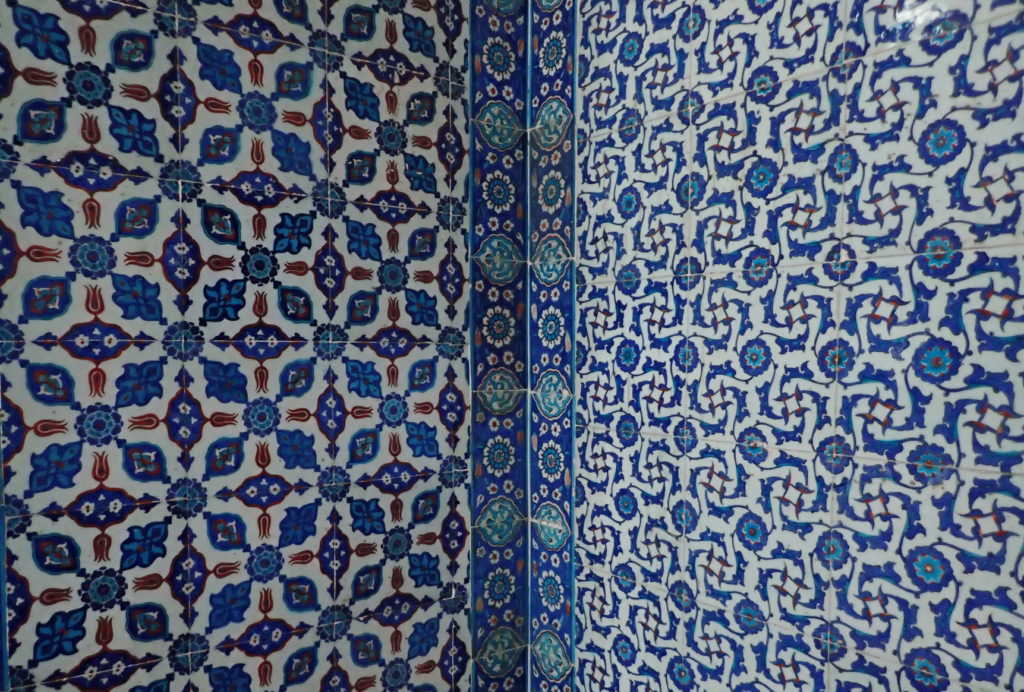
Mimar Sinan designed the Rüstem Pasha Mosque for Grand Vizier (head of government) Rüstem Pasha, son-in-law of the Sultan. He had married Mihrimah Sultan, daughter of Suleiman the Magnificent by Roxelana. The story of the Mosque is less inspiring – but perhaps not less interesting – than others. Accounts of Grand Vizier Rüstem Pasha vary greatly. Some accounts portray him as a man of uncommon virtue, modesty, and generosity. He had come from humble circumstances and risen in his career through his own hard work and merit. Through his diligence and prudence, he amassed great wealth even before his marriage and appointment, and distributed this wealth generously through charitable foundations.
Other accounts dub him the “Louse of Fortune” (Kehle-i-Ikbal), rumoring him to have been infected with lice when he married Mihramah. The name reflected his alternative reputation as a generally loathsome character.
Accounts agree on at least two things- that he was involved in persuading the Sultan to have his son Mustafa strangled, and that he had this elaborate Mosque constructed. Whether the magnificence of the Rüstem Pasha mosque is an attempt to atone for his life or to give his virtue glorious expression is uncertain. The splendor of the Mosque answers either purpose.
A Jewelbox Hidden in the Marketplace
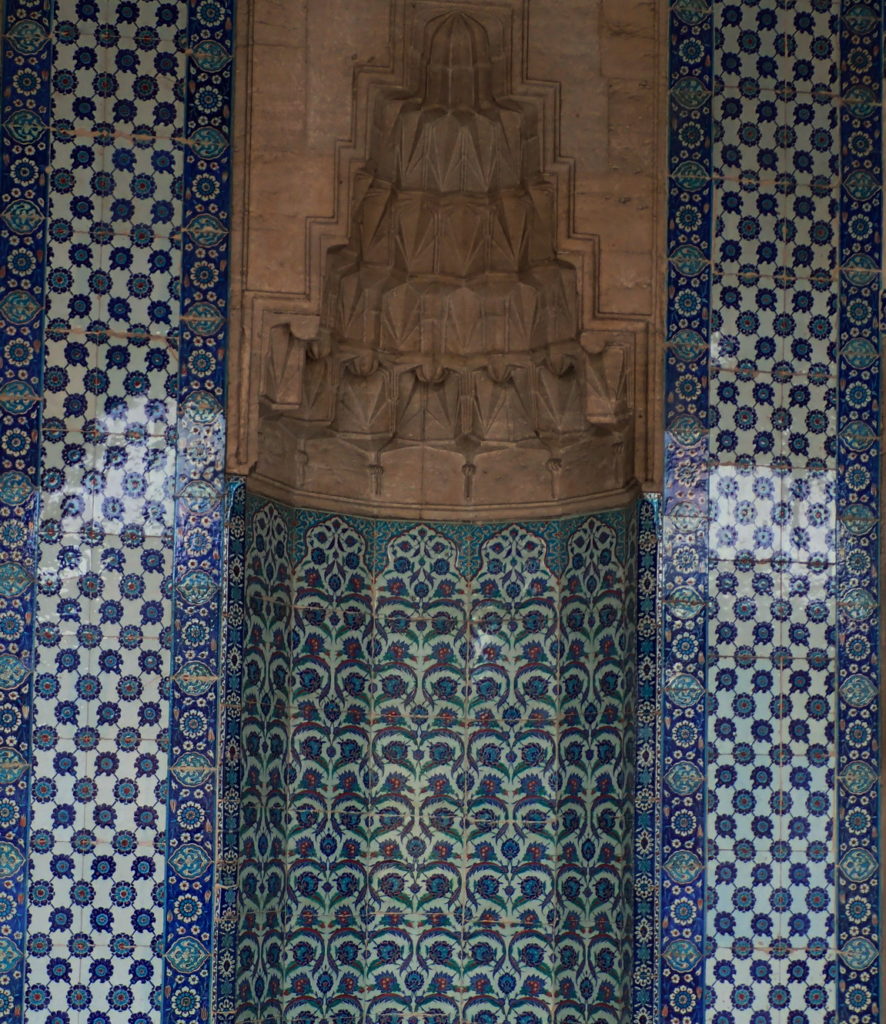
It is an unusual place to find the Mosque of a Grand Vizier. A corner of the sprawling Spice Market is called the Hasırcılar Çarşısı – the Straw mat weavers’ market. It’s a place of loud commerce and cheerful chaos. Mimar Sinan took the location into account, and built the Mosque above the noise of the street. The entrance is hard to find. You ascend a shabby and unpromising staircase between warehouses. But the surprise of the tiled splendor that greets you is all the greater for it.
The Glory of Iznik Tiles
If you shop for souvenirs in the Grand Bazar or the many tourist shops of Sultanahmet, you will see beautiful tiles. These are copies of the famous Iznik tiles.
Iznik is ancient Nicaea, a town in Bursa on the Sea of Marmara that became known for its ceramic production. From the 16th century, craftsmen began adding to their palette of cobalt and sage green. Turquoise, red,and a deep emerald green joined their palette, and the style became more flowing and expressive.
Mimar Sinan made use great of Iznik tiles, and nowhere more beautifully than in the Rüstem Pasha Mosque. Over 2,300 jewel-like tiles of many patterns cover the exterior, and most of the walls inside as well.The effect is truly dazzling.
Please note- the Rüstem Pasha Mosque was closed for renovations when we visited Istanbul in July of 2019. I happily had seen it on a previous visit.
Islam and the Urban Experience
Istanbul’s many mosques shape the urban landscape. They are much more than a part of the visual experience. With the muezzin ascending the minarets five times daily to call for prayer, Islam is the very rhythm of the city. The path of the sun determines the times of calls for prayer. They are closer together in winter than in the long days of summer. It is a keeper of time, a reminder to transcend the cares of the moment.
The sound is glorious. From the height Süleymaniye Mosque, the muezzin’s call to prayer joins that of many others, echoing from the hills and from across the Bosporus and the Golden Horn. Visiting several Mosques is an essential Istanbul experience.
Visiting Mimar Sinan’s Mosques with Context Tours
Our intensive and fascinating private tour with Ebru of Context Tours gave us a complete overview of the history of the Ottoman Empire and the social and cultural context to make the most of our experience. Our guide also opened our eyes to the mystery and beauty of Islamic architecture and elements of design that enhanced the whole of our stay in Istanbul, and our appreciation of Ottoman architecture and history in general. It was deeply enriching. Context Tours offers many focused, in-depth tours to give you an unique and transforming experience of Istanbul

